Composition and proportions of concrete grades, components and preparation
Concrete is the bread of construction. Any construction site cannot do without it, various structures and products are produced from construction - foundations, walls, stairs - to decorative - benches, garden paths and small architectural forms. And all this is a mixture of simple composition. True, the proportions of concrete and its characteristics can be very different - for different tasks.
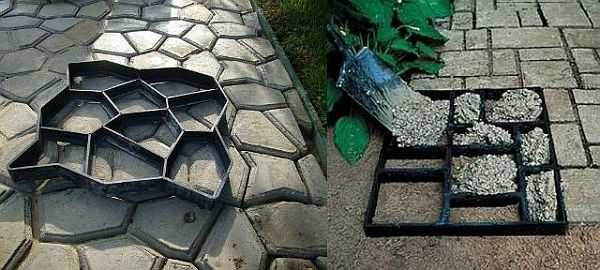
Large multi-storey buildings, walkways and small sculptures are made of concrete. For this, concrete of different composition is used.
The content of the article
Concrete composition: components, their sizes and characteristics
For the most part, concrete consists of three main components:
- The binder is most often cement, sometimes lime.
- Aggregates - sand, gravel, pebbles.
- Water.
A different amount of only three components gives a wide range of qualities and characteristics. To impart special properties, various additives and additives are also used, which further expands the field of use of this material many times over.
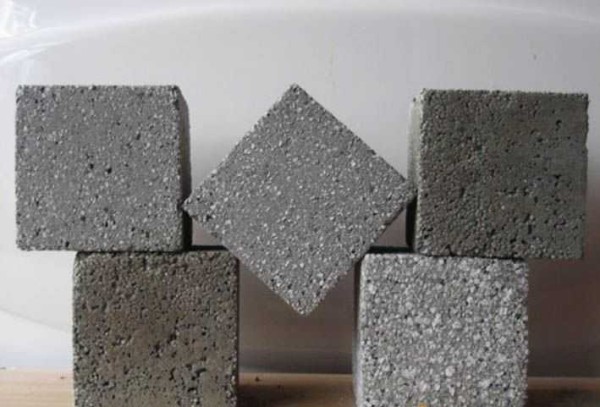
All these grades of concrete are made from the same components, but in different proportions
The main characteristic of concrete is its strength or the load that it can withstand for a long time without losing its strength characteristics. This parameter is the key when choosing a grade of concrete for the foundation. Water permeability and frost resistance may also be important. But these are the characteristics of the "matured" material, which depend on the recipe. And when mixing, you may be interested in such a characteristic as workability. It reflects the degree of concrete flow and depends on the amount of water in the composition. It is possible to increase fluidity without adding water using additives, as well as to increase frost resistance and water repellency.
The strength of concrete depends on how accurately the recipe was adhered to, on the quality of the components and on how thoroughly everything was mixed. Only with a homogeneous composition and quality components can design characteristics be achieved. Read more about what components can be used and the requirements for them at the end of the article.
Concrete marking principle
The main characteristics of concrete are its strength and compressive class. Compressive class is designated by the letter "B" followed by the numbers of the class from 3 to 40, the strength grade is designated by the letter "M", after which there are numbers from 50 to 1000. They indicate the maximum load that this type of concrete can bear. For example, the M300 brand means that the maximum load per square centimeter cannot be higher than 300 kg.
In private construction, the most popular brands are M200-M250, concrete M300-M350 can be used for the foundations of two-story houses, much less often M400 is poured - for heavy buildings on difficult soils. Higher ones are generally rare. Their field of application is industrial construction and facilities with special properties (piers, dams, roads, etc.).
The correspondence between the grades of concrete in terms of strength and compression is given in the table (used in private construction).
| Compressive strength class of concrete | Compressive strength of concrete kg / cm2 | The closest concrete grade by strength |
|---|---|---|
| AT 5 | 65.5 | M 75 |
| B 7.5 | 98.2 | M 100 |
| B 10 | 131.0 | M 150 |
| B 12.5 | 163.7 | M 150 |
| B 15 | 196.5 | M 200 |
| B 20 | 261.9 | M 250 |
| B 22.5 | 294.4 | M 300 |
| B 25 | 327.4 | M 350 |
| B 30 | 392.9 | M 400 |
| B 35 | 458.4 | M 450 |
| B 40 | 523.5 | M 500 |
The proportions of concrete of different brands
All this assortment and spectrum of qualities is obtained using the same materials, just in different quantities. To achieve the required characteristics, the recommended proportions must be strictly observed.
When building your house, you want to do everything as best as possible, and therefore, when composing concrete, there is a desire to add more cement: to make it stronger. This should not be done. It is unlikely to get better, but worse - easily. To cure concrete, a certain amount of water and other components is needed. If there is little water, there is a lot of cement, bonds between particles are formed in insufficient quantities, which can cause the concrete to crack and crumble. The same applies to the number of placeholders. And too much of their content, and insufficient, negatively affects the qualities of the concrete stone.
The proportions of concrete are usually displayed in fractions. The amount of cement is taken as a unit, and the remaining components are prescribed in relation to it. The data are given in the form of tables for the respective brands, units of measurement are required. You can see such a table of concrete components below.
How to determine the required proportions of concrete from this table? Find the grade of concrete required in the second column. For example, you need an M250. Depending on which Portland cement you will use M 400 or M 500, choose one of two lines. The third column shows the proportions for concrete in kilograms: for 400 cement it is 1 / 2.1 / 3.9. This means this: to obtain concrete of the M 250 grade, for 1 kg of M400 Portland cement, 2.1 kg of sand and 3.9 kg of crushed stone must be added. In a similar way, you determine the proportions for concrete M200 - the data for it in the table are slightly higher, or concrete M 300 - slightly lower.
The fourth column shows the volume fractions: all components are given per 10 liters. They are selected in the same way.
These tables do not indicate the amount of water. It depends on how thick you need the solution. The water-cement ratio is given in separate tables. For example, the following data are given on the number of inputs in relation to a kilogram of cement, provided that medium sized aggregates are used.
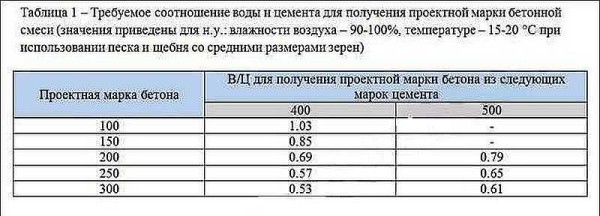
The amount of water to obtain concrete of the required grade when using crushed stone and sand of medium size
For example, to obtain concrete grade M 300, the proportions of cement M 500 and water are defined as 0.61. This means that 0.61 liters of water (610 ml) is added to the solution for 1 kg of cement. This produces a medium plastic solution that is used most often.But when pouring foundations or other structures with thick reinforcement, a plastic mortar may be needed. Then, when determining the amount of water, in addition to the brand of cement, it is also necessary to take into account the size of the aggregates and how fluid the solution should be. These data are presented in the table below.
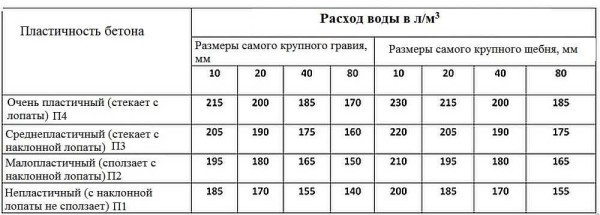
The amount of water in the concrete depending on the size of crushed stone / gravel and the fluidity of the solution
Sometimes it is necessary to determine how much cement you need for a particular task. To do this, you need to know how much cement is contained in a cubic meter of concrete. You will find data on concrete and cement grades in the table below.
Areas of use
We decided on what materials for concrete are required in what proportions, but what brand is needed? It depends on the purpose of the structure and the conditions of its operation. It will be easier to navigate if you know what grades of concrete can be used for what (we will name only those that are used in the construction of a private house, its repair or arrangement of a site).
M100 (B7.5). This is the so-called skinny concrete. It is used to prepare the site for critical structures. For example, during construction strip foundation a layer of lean concrete is laid on the gravel-sand bed, and then they begin reinforcement work... The same composition is used when laying a curbstone, for example, in the manufacture of paths or blind areas around the house.
M150 (B12.5). This composition is used in preparation for slab foundations, for screeds, pouring concrete floors or garden paths. This type of concrete can be used to make foundations for small lightweight buildings such as a wooden bathhouse or a small guest house made of timber or logs.
M200 (B15). One of the most popular brands of concrete. Foundations of any type are made from it for light houses on normal soils, screeds, stairs, blind areas, paths. Concrete of this brand is used to make cement blocks at home, it is also used in factories for the manufacture of foundation and building blocks.
How to build yourselfthe foundation of FBS blocks read here.

The ratio of cement and sand for concrete affects the strength characteristics
M250 (B20).The area of application is practically the same, but in more difficult conditions. Any foundations are made on difficult soils, or on normal ones, but for houses built of heavy materials. They make blind areas that will be used as paths, outdoor stairs, concreting porch, fences, etc. Also, floor slabs are made from it at low loads.
M300 (B22.5).Also suitable for all areas listed above, but in even more severe operating conditions. They make foundations for heavy houses on heaving soils, make monolithic walls, paths, a waterproof blind area, etc. Floor slabs and grillages for pile-grillage foundations are mainly made of this grade of concrete.
M350 (B25). The strength of this brand for private construction is mostly excessive. This concrete is used for the construction of monolithic pool bowls or for the manufacture of foundations with a high level of groundwater, for other structures requiring high water resistance. This brand is already more often used in industrial construction.
M400 (B30).This is already an expensive brand of concrete, which is used in facilities with special requirements: for large swimming pools, dams, storage facilities in banks, etc.
Concrete preparation
For large volumes of work, it is better to order concrete from the factory. Making a large amount of mortar by hand or even using concrete mixers is a difficult task, and laying in portions requires additional effort to ensure that the layers adhere well. However, you can also make concrete by hand. In this case, there are two sequences of actions:
- First, concrete and sand are mixed dry. It is mixed until the color is uniform. Then crushed stone is poured, everything is mixed again, and water is added last.
- First, water is poured, cement is poured into it. When everything is mixed, add sand and then coarse aggregate.
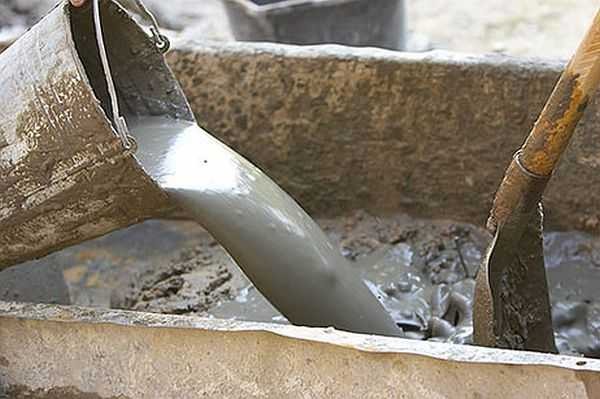
The order of adding components for concrete during mixing can be different
In the first option, there is a possibility that with manual mixing, an unmixed composition will remain at the bottom, near the walls of the container, which will lead to a decrease in the strength of concrete. The way out is to mix everything well and thoroughly. But you cannot spend too much time on this: the solution will begin to set.
The second option has its drawbacks: it sometimes takes a lot of time to obtain a homogeneous cement milk (a mixture of water and cement). As a result, it is simply not enough for the formation of bonds with the backfill: the cement “seizes” and the strength of the concrete also decreases.
All this is not so critical when using concrete mixers, but also imperfect. There is another complication here. The concrete is delivered to the construction site usually in trolleys. The entire volume does not fit into one, and the remainder is left to spin in a concrete mixer. This is better than leaving it just standing, but if you stir it for too long, the solution may begin to stratify, the result is that the strength of the concrete will be lower. Exit - two carts and two people who will take them.The filling method - the first or the second - choose yourself.
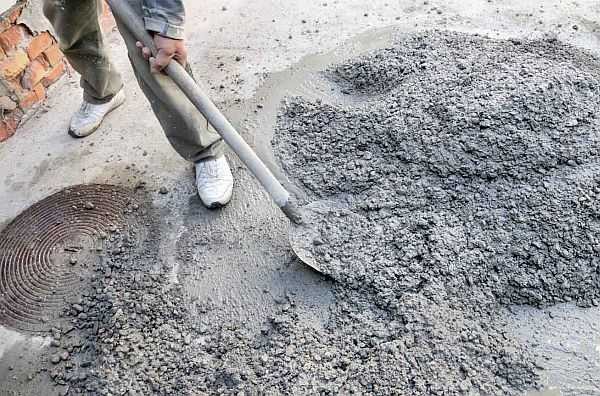
For small volumes, concrete can be mixed by hand
So after all, how to prepare concrete. The choice is yours. If the volumes are small, you can knead by hand. Just do it carefully. For pouring the foundation, it is better to order a mixer, but you can do it with a concrete mixer (or two, depending on the volume). And to solve problems with the heterogeneity of the mix (although it is better that it be good), process the concrete to be placed with a vibrator. Most of the problems will go away.
Next, let's talk about the requirements for concrete components, their sizes and qualities.
Requirements for cements for concrete
For most of the construction work, cement concrete is used, where Portland cement is used as a binder. There is also limestone, but its scope is limited mainly by finishing work, which is done "the old fashioned way."
Portland cement types and storage
There are several types of Portland cement - slag Portland cement, alumina and pozzolanic. All of them differ slightly in characteristics, but any is suitable for private construction. The difference can only affect the setting time: slag Portland cement does not freeze the longest - up to 12 hours, then standard Portland cement goes - up to 10 hours, and the alumina binder hardens the fastest - no more than 8 hours.
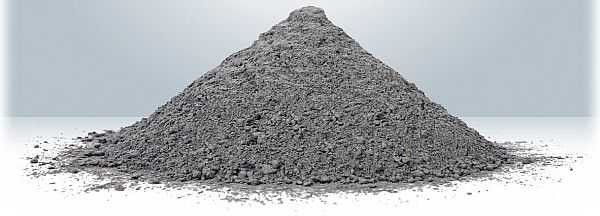
The cement for concrete must be dry, free-flowing and fresh
Cement is picky about storage conditions, and especially moisture. For the manufacture of important structures - foundations, floors, etc. preferably fresh, fresh from the factory. Within a month, it loses up to 10% of its properties, and after 6 months they deteriorate by 30-35%. Therefore, for example, to fill the foundation, it is better to take it a maximum of two weeks ago, and purchase it shortly before use.
Store in a dry ventilated area. If there is no room, they are folded under a roof or wrapped from moisture with several layers of film. Pay attention - by wrapping, not covering. And preferably not on the ground, but on a wooden flooring. The thing is that when moisture gets in, even in a vaporous state, the cement becomes lumpy, which greatly impairs the characteristics of concrete. With an abundance of moisture, it simply becomes a stone and there is no way to use it. Therefore, take care of a place for storing cement in advance.
Cement marking
What brand of cement you need to take is usually indicated in the concrete recipe. It is denoted by the letter M and numbers that indicate the maximum concrete strength that can be achieved with this binder. For example, with cement grade M400, concrete of grade M400 can be obtained as much as possible, as well as lower ones.
Next comes the letter "D" and numbers indicating the amount of impurities. M400 D15, means that the impurities in the binder are 15%. For construction work, this figure should not be more than 20%.
Aggregates - crushed stone and sand
The composition of concrete is determined by those functions and characteristics of concrete that are necessary during its operation. The most common are sand and gravel. They are subject to no less stringent requirements than the quality of cement. Pebbles are sometimes used, but only if they have sharp edges, and not round ones. In the presence of broken lines, the adhesion of the aggregate to the mortar is better, as a result, the strength of the concrete is much higher.
Sand
Construction sand can be river or quarry. The river is more expensive, but it is usually cleaner and has a more uniform structure. It is better to use it when drawing up concrete for pouring the foundation, screed. For masonry or plastering, it is appropriate to use cheaper quarry sand.
In addition to origin, sand is distinguished by fractions. Large or medium-sized ones are used for construction work. Small and dusty ones are not suitable. The normal size of sand grains is from 1.5 mm to 5 mm. But optimally in solution it should be more uniform, with a difference in grain size of 1-2 mm.
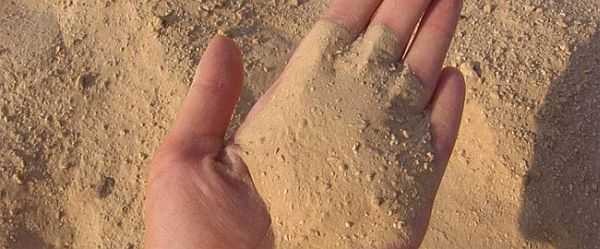
The sand should be clean, preferably with the same grain size
The purity of the sand is also important. It definitely should not contain any extraneous organic inclusions - roots, stones, pieces of clay, etc. Even the dust content is standardized. For example, when mixing concrete for a foundation, the amount of contamination should not exceed 5%. This is determined empirically. 300 ml of sand is poured into a half-liter container, everything is filled with water. A minute later, when the grains of sand settle, the water is drained and poured again. This is repeated until it is transparent. After that, it is determined how much sand is left. If the difference is not more than 5%, the sand is clean and can be used when mixing concrete for the foundation.
For those works where the presence of clay or lime is only a plus - when laying or plastering - there is no need to take special care of the purity of the sand. There should be no organic matter and stones, and the presence of clay or lime dust will only make the solution more plastic.
Crushed stone
For responsible construction - floors and foundations - crushed crushed stone is used. It has sharp edges that adhere better to the mortar, giving the structure more strength.
Crushed stone fractions are standard:
- extra small 3-10 mm;
- small 10-12 mm;
- average 20-40 mm;
- large 40-70 mm.
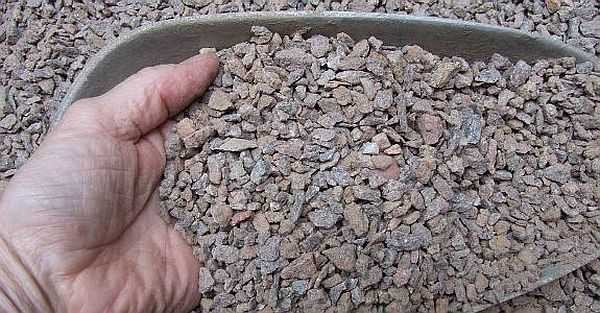
In the batch, crushed stone is used in several fractions - from small to large
Several different fractions are used simultaneously in concrete. The largest fragment should not exceed 1/3 the size of the smallest element of the structure to be filled. Let us explain. If a reinforced foundation is poured, then the structural element that is taken into account is reinforcement. Find the two closest elements. The largest stone should not be more than 1/3 of this distance. In the case of filling blind areas the smallest dimension is the thickness of the concrete layer. Choose crushed stone so that it is no more than a third of its thickness.
Fine crushed stone should be about 30%. The rest of the volume is divided between medium and large in an arbitrary proportion. Pay attention to the dustiness of crushed stone. Lime dust is especially undesirable. If there is a lot of it, the rubble is washed, then it is dried, and only after that it is poured into concrete.
Storing placeholders
It is clear that the construction site is not the cleanest and most equipped place, and sand and rubble are often dumped directly onto the ground. In this case, when loading, it is necessary to ensure that no earth gets into the batch. Even a small amount of it will negatively affect the quality. Therefore, it is advisable to pour aggregates onto solid areas.
It is also necessary to protect them from precipitation. In concrete formulations, the amount of constituents is given in terms of dry components. Taking into account the moisture content of components is learned with experience. If you do not have one, you have to take care of the condition and cover the sand and gravel from rain and dew.
Water
Potable water should be used to obtain concrete of normal quality. So it is written in SNiP: “drinking, including after boiling”. You cannot take water from a river or lake, especially technical water. No contaminants, acids, salts, alkalis, oils, etc. All these substances negatively affect the strength of concrete, and worst of all - the result is impossible to predict.

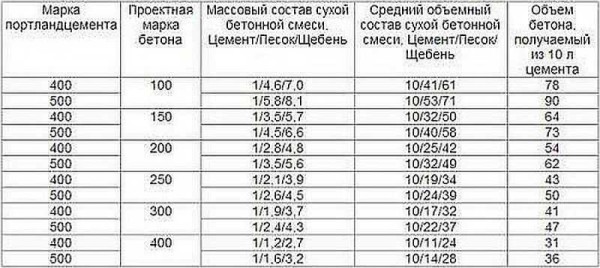
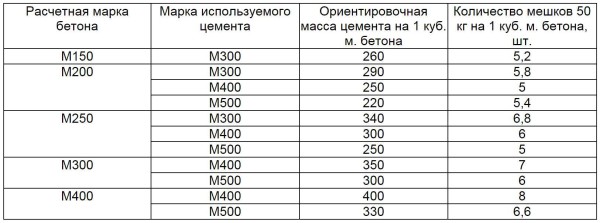










To obtain a good result, it is advisable to take a filler of different sizes for concrete. A large number of voids will increase the consumption of cement, and, accordingly, the money spent, since cement is the most expensive component of the concrete mixture.Fillers of different sizes will reduce the amount of voids.